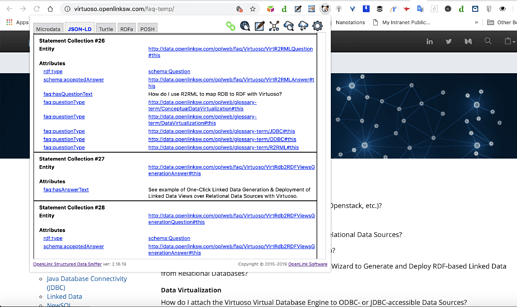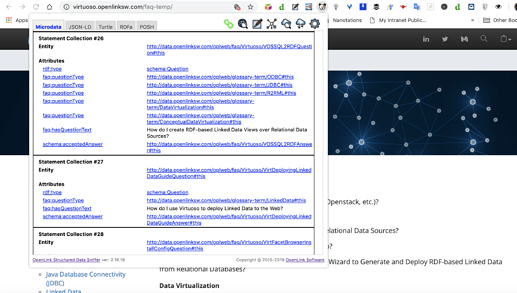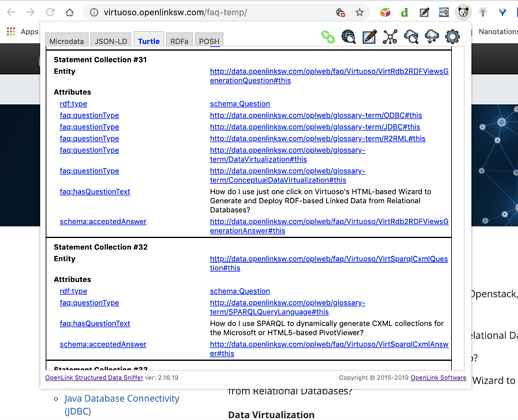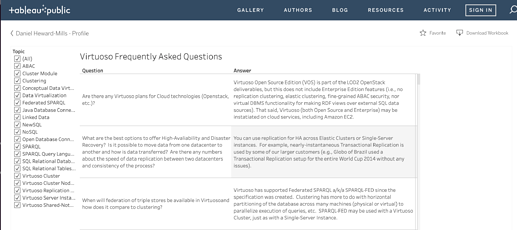As at any other organization in the Web era, we at OpenLink Software depend on our Web Site being treated as the canonical source of information related to our fundamental value proposition. As is often the case, this is a little more complicated in reality – as our own Web Site demonstrates.
Looking at our Web site conventionally (i.e., through a typical web browser, as most would), the content appears to be static and somewhat inconsistent with the technological and technical capabilities associated with our company.
Our Challenge
We need to harmonize our Web content with our technical and artistic capabilities. Basically, we need to make our websites (Virtuoso, UDA, and Company) showcase the virtues of a Website that is dynamically driven by an underlying Company Knowledge Graph that manifests as a Semantic Web of Linked Data.
In a nutshell, we need to increase the Agility of our Website Development & Deployment.
Our Solution
We address this challenge by using RDF and Linked Data principles to incorporate data from an Enterprise Knowledge Graph into the process of website development and deployment.
The process breaks down to the following steps:
- Identify all relevant entities (Software Applications, Licenses, Web Pages, etc.) using hyperlinks (specifically, HTTP URIs)
- Describe everything using RDF sentences in conformance with Linked Data principles
- Save entity descriptions to relevant RDF Documents (which then manifest as Named Graphs in our Virtuoso RDBMS)
- Establish a Web Space
- Build Page Templates associated with Web Space
- Inject content from the underlying Virtuoso RDBMS into Page Templates (using approaches similar to those popularized in Desktop Publishing eons ago)
- Share our final product with the world, piecemeal rather than as one “big bang” event
How We Do It
Courtesy of our OpenLink Structured Data Inclusion-Engine (OSDI), we can add a fair degree of automation to the solution steps outlined above by:
-
Injecting structured data islands into each page, such that each page manifests a launch-point for Semantic Web of Linked Data exploration that also provides Semantic Search Engine Optimization (SSEO)
-
Generating content for page templates by retrieving and injecting data directly from the underlying Virtuoso RDBMS
Live Examples
-
Frequently Asked Questions (FAQ) Page
-
Structured Data Sniffer Browser Extension revealing JSON-LD based Metadata injected into HTML doc via OSDI
-
Structured Data Sniffer Browser Extension revealing MicroData based Metadata injected into HTML doc via OSDI
-
Structured Data Sniffer Browser Extension revealing RDF-Turtle based Metadata injected into HTML doc via OSDI
-
Structured Data Sniffer Browser Extension revealing POSH based Metadata injected into HTML doc via OSDI that reveals SPARQL Query Solution Doc URIs for Query used to populate page
-
-
Tableau Data Visualization Collection
-
Tableau Screenshot – Query Results from SPARQL CSV-based Query Solution Doc
-
-
Airtable Data Visualization Collection
-
Airtable Screenshot – Query Results from SPARQL CSV-based Query Solution Doc
-
Universal Data Access Drivers (UDA) Site
This site hosts a collection of documents related to our various ODBC, JDBC, ADO.NET, OLE-DB Driver Types.
Universal Data Access (UDA) General
Lite Edition Drivers
Conclusion
In classic two-fer fashion, completing this challenging effort has enabled us both to reach our desired enterprise agility levels and to significantly enhance the hands-on expertise of every employee in the process. Best of all, we can share this level and kind of agility with our customers through improved services while simultaneously making the virtues of our product portfolio easier for those same customers and prospects to understand and exploit.





